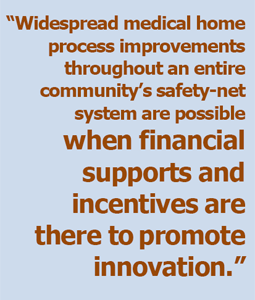Synopsis
After Hurricane Katrina knocked out New Orleans' main public hospital and much of the region's health care network, the federal government awarded Louisiana $100 million to restore and expand its safety-net services. The state used the funding to transform community-based clinics into patient-centered medical homes that provide round-the-clock access to primary care and other enhanced services for patients. Researchers have found that the program dramatically increased access to primary care services for area residents between June 2008 and June 2010, though progress stalled somewhat as grant funding ran out.
The Issue
To foster the development of patient-centered medical homes (PCMHs), Louisiana offered community-based clinics that met nationally recognized PCMH standards substantial bonus payments. The state also provided the clinics—which included federally qualified health centers, free community-based clinics, faith-based organizations, public sector and university-affiliated primary care clinics, and behavioral health clinics—advice on data collection and reporting, as well as a set of basic quality standards. As part of a Commonwealth Fund–supported study, researchers examined the program's impact on the safety net by using a medical home index that measures enhanced access, quality and safety, and care coordination and integration.
Key Findings
- While many of the clinics began with no infrastructure in place for appointment scheduling, billing, or data collection and reporting, on the whole they made substantial progress implementing medical home processes that improved access, quality, safety, care coordination, and integration. The average score on the 100-point medical home index increased by 16.5 points over a two-year period.
- Quality and safety scores on such items as use of guideline-based reminders for providers and systems to improve breast cancer screening and tobacco cessation increased early in the observation period (June 2008–June 2010). Scores for care coordination and integration—for example, information-sharing among specialists and hospitals, and use of electronic health records and chronic disease registries—improved somewhat later.
- Scores for enhanced access also improved during the study period, largely reflecting improvements in responding to urgent phone calls after hours and on weekends, the increased use of e-mails between providers and patients, and improvements in access to translation services.
- There was wide variation across clinics in overall medical home scores and in trajectories of change over time. No clinic implemented every medical home process, and several clinics made only minimal progress.
- All scores declined at the end of study period in June 2010, when the clinics were no longer eligible for bonus payments and their focus shifted from growth and transformation to consolidation and survival. Overall, there was a 1.9-percentage-point decrease in the total PCMH index score between December 2009 and June 2010.
Addressing the Problem 
Financial incentives, including bonus payments for high performance, can reward leaders, provide a business case for sustaining change, and stimulate action in clinics poised for change. But to sustain change, payment models must be robust and stable. Safety-net clinics may also need additional support in the form of community-based assistance with primary care redesign.
About the Study
The authors surveyed 50 clinics in the New Orleans area about organizational characteristics and clinical processes to improve access, quality and safety, and care coordination and integration. They also interviewed the leader of each clinic.
The Bottom Line
Given the right incentives, safety-net primary care clinics can make the transition to become patient-centered medical homes. The results of the New Orleans program, however, underscore that primary care transformation is a long process, and one difficult to achieve and sustain.


